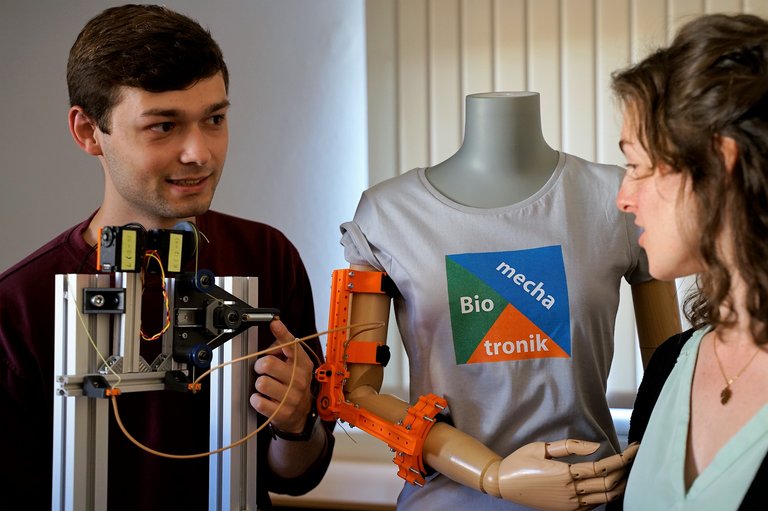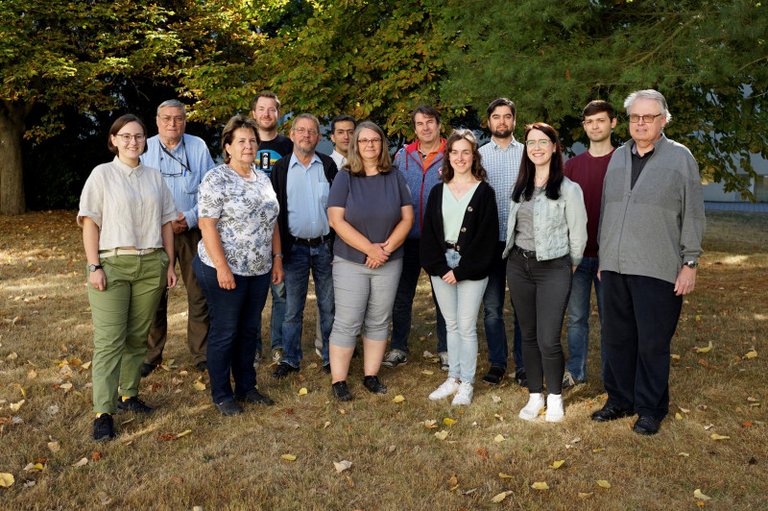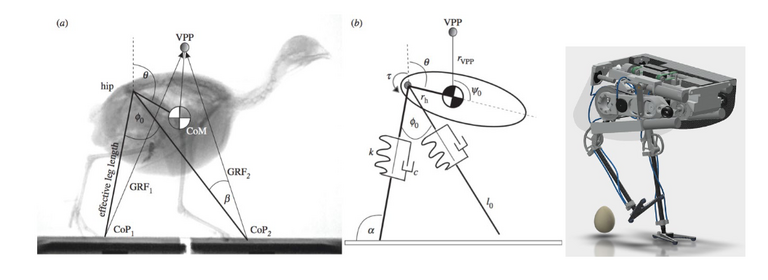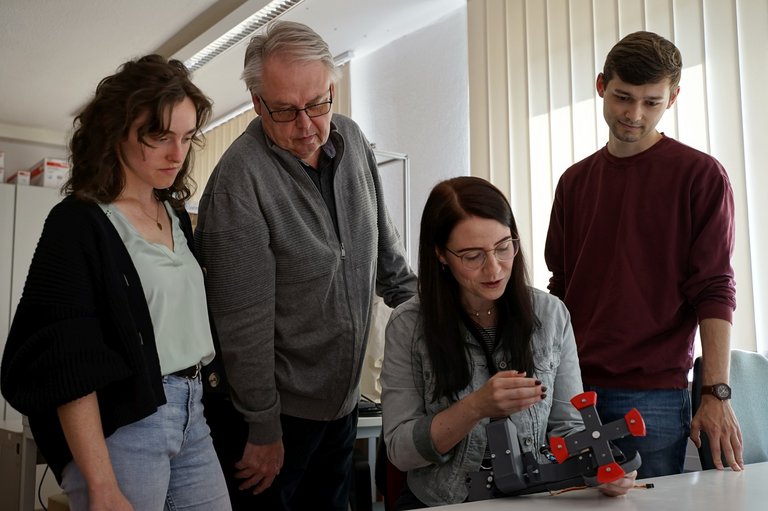With its goal of making findings from the life sciences of biology and medicine usable for technology, biomechatronics is more relevant today than ever before. Founded in 2002 at the Department of Mechanical Engineering as Germany's first professorship in this field, the Group of Biomechatronics at TU Ilmenau is still the only university chair that acts as a bridging subject linking mechatronics with biology and medicine. This results in assistance systems for humans and mechatronic systems for biology or forestry, as well as bionic products such as climbing robots or robotic grippers. On the occasion of the 20th anniversary, founding professor Hartmut Witte looks back at the beginnings of the subject and presents current research projects.

How can limited functions of the human body be supported with the help of technical functions? And how can technical processes be optimized or technical movement systems be developed based on biological models? These questions were already on the minds of Dr. Hartmut Witte, who holds a degree in mechanical engineering and a postdoctoral qualification in anatomy, in the 1990s. At that time, he was a scientist at the Institute of Special Zoology and Evolutionary Biology at the Friedrich Schiller University in Jena and developed the four-legged bio-inspired walking machine BISAM in collaboration with the Research Center for Information Technology in Karlsruhe.
After his appointment at the TU Ilmenau, Prof. Witte, together with senior assistant Dr. rer. nat. Cornelius Schilling and Dipl.-BW. (FH) Wolfgang Kempf, he started his scientific research work on May 2, 2002 in a barrack at the Ilmenau ponds. Prof. Witte looks back to the beginnings of biomechatronics at the TU Ilmenau:
Since the subject was completely newly established, we had no 'scientific heritage' to carry on, on the one hand, and no material infrastructure to take over, on the other.
So we improvised, and with two projects from the German Federal Ministry of Education and Research (BMBF), Prof. Witte and his team quickly entered the two core areas of the subject, technical biology and bionics ("Bio4Eng") and assistance systems ("Eng4Bio"). At that time, biomechatronics was already planned as a specialization in the main course of the diploma program in mechatronics, Dr. Schilling recalls:
Seven students had already been waiting energetically for a year in some cases for the offer to start, which we were then able to realize immediately for the summer semester that was already underway.
The department also grew quickly with the addition of another biologist, a doctoral student, and an administrative assistant, whose home department of industrial science, led by Prof. Peter Kurz, already pointed the way to the later merger of the two departments: after several moves, the two departments came together on one floor in the Werner Bischoff Building in 2006, and after Prof. Kurz's retirement due to age, the department of biomechatronics took over parts of the tasks of the department of industrial science in 2017. During this time, the department grew from an initial three to as many as fourteen scientists. Research was also continuously supported by external doctoral students.
Running, climbing, grasping: technology modeled on nature
"In the first ten years, the work on bionics, primarily biologically inspired robots, attracted the greatest interest from the public and those interested in studying the subject," recalls Prof. Witte. Building on this, in collaboration with EPFL Lausanne, Prof. Auke Jan Ijspeert, graduates of TU Ilmenau as PhD students in 2015 were able to realize the mammal-like walking machine as a four-legged robotic cat, a so-called CHEETAH-Cub, which Prof. Witte had been striving for since his Jena days. Currently, in this tradition, under the coordination of PD Dr.-Ing. habil. Emanuel Andrada in cooperation with Gentle Robotics eNandu, a two-legged walking machine modeled on birds. "Such fast and agile little machines can be used for reconnaissance during search and rescue missions after natural disasters, for example, but they can also deliver packages in everyday life," says Prof. Witte. The department has just completed a project to develop a biologically inspired gripper for glass.
Preserving or restoring individual abilities in old age
Parallel to this, but only more strongly perceived by the public as the "bionics hype" subsided, the department's activities in the field of "Eng4Bio" grew, in particular the development of assistance systems for mobility-impaired and elderly people ("Human Serving Systems"). Developments such as a virtual reality-supported training system for the prevention of muscular deficits are intended to help preserve, restore or even expand individual abilities into old age. Prof. Witte:
This also resulted in the research in audiology that continues to this day, the continuation of our studies on human locomotion, and collaborations with hospitals and companies on medical issues.
In the course of cooperation with the Department of Occupational Science, usability became a steadily growing field of research, supervised by the current senior assistant Dr.-Ing. Stefan Lutherdt. Currently, a team led by Dipl.-Ing. Thomas Helbig is further developing a modular active exoskeleton of the upper extremity for the prevention of musculoskeletal diseases, which was created as part of a BMF joint project with three universities and three companies, and which can follow the wishes of the user much faster than previous systems through the innovative use of electro-myography (EMG) signals.
On the move in the forest with "Whegs
In application-oriented research, the department is active, among other things, in the measurement of trees and is currently developing a cost- and handling-optimized device with which the growth of the trunk circumference can be measured and recorded - an important indicator of the vitality of a tree. Prof. Witte:
In contrast to classical manual measurement methods, a precise measurement of the thickness growth of a tree trunk with a high temporal resolution can provide better information about effects of the location, in particular the climatic situation. In this way, we would like to make a contribution to forest monitoring against the background of the forest restructuring that is necessary due to climate change.
The department also plans to soon be out and about in the forest with an all-terrain robot developed by Dipl.-Ing. Sebastian Köhring, according to Prof. Witte:
The "Whegs," which can switch smoothly between rolling onwheelsand striding and climbing on legs, are ideal for use in the forest.
The fact that biomechatronics is characterized above all by its strong interdisciplinarity is reflected in the fact that the department is involved in teaching in all faculties. Master's students in mechatronics with an elective focus on biomechatronics and students in biomedical engineering form the largest target group:
Those who love interdisciplinary work and are enthusiastic about engineering AND biology as well as medicine can already develop their talents in biomechatronics during their studies at the TU Ilmenau and work on diverse research projects in mechatronics or biomedical engineering at an early stage.
Contact
Prof. Dr. med. (habil.) Hartmut Witte
Hed of the Biomechatronics Group




